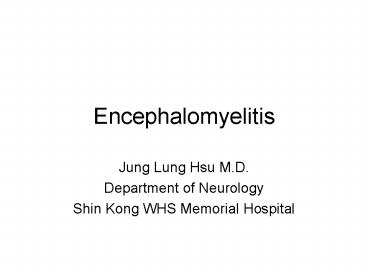Encephalomyelitis - PowerPoint PPT Presentation
1 / 22
Title:
Encephalomyelitis
Description:
Acute infection of brain parenchyma characterized clinically by fever, headache ... by fever, throat pain and lesion in buccal mucosa, duration is 2-3 weeks ... – PowerPoint PPT presentation
Number of Views:64
Avg rating:3.0/5.0
Title: Encephalomyelitis
1
Encephalomyelitis
- Jung Lung Hsu M.D.
- Department of Neurology
- Shin Kong WHS Memorial Hospital
2
Encephalitis
- Definition
- Acute infection of brain parenchyma characterized
clinically by fever, headache and altered level
of consciousness, may associated with focal or
multifocal neurological deficits and focal or
generalized seizure activity
3
Major etiology
- Major cause of encephalitis
- Herpes simplex virus type 1 (HSV-1)
- Herpes simplex virus type 2 (HSV-2) in neonate
- Mumps
- Arthropodborne virus St Louis encephalitis
virus, Japanese B encephalitis - Tickborne rickettsial infection Rocky Mountain
spotted fever
4
Immunocompromised patient
- Causal agent of encephalitis in the
immunocompromised patient - HIV
- HSV
- Varicella zoster virus (VZV)
- Epstein Barr virus (EBV)
- Cytomegalovirus (CMV)
- Human herpes virus-6 (HHV-6)
- Enterovirus
5
Postinfectious encephalomyelitis
- Definition acute inflammatory demyelinating
disease of brain, optic nerves and spinal cord
that typically occurs a few days or weeks after a
respiratory tract infection or after a
vaccination - Postulated to be an autoimmune disease of the CNS
- Encephalitis and postinfectious encephalitis can
not be distinguished by clinical presentation
6
Sporadic and epidemic encephalitis
- Sporadic encephalitis
- 3 major virus HSV, mumps and EBV
- Most common is HSV
- Epidemic encephalitis
- Arbovirus such as JCV
- Von Economos encephalitis lethargica
- Fever, consciousness change than movement
disorder - Triad oculogyric crisis, psychiatric/personality
change and involuntary movement
7
Chronic encephalitis
- Subacute/chronic virus encephalitis syndrome
cause by slow virus - Slow virus long latency, typical disease
progression course, single spaces transmission - Conventional virus measle (SSPE), rubella (PRP),
retrovirus (AIDS dementia), papova virus (PML) - Unconventional virus prion diseaseCreutzfeldt-Ja
kob disease, Gerstmann-Straussler disease, Bovine
spongiform encephalitis
8
Herpes simplex encephalitis
- Acute sporadic encephalitis
- Age distribution biphasic model, 5-30y/o and
over 50y/o 95 is type 1 - Primary infection is asymptomatic, occurs in the
oropharyngeal mucosa - Symptomatic disease is characterized by fever,
throat pain and lesion in buccal mucosa, duration
is 2-3 weeks
9
Herpes simplex encephalitis
- Infection route from mucosa transport by
retrograde transneuronal spread to trigeminal
nerve - Reactivation of virus than?trigeminal root and
come to temporal/frontal lobe - Immunosuppression increase the risk of
reactivation of virus
10
Clinical presentation
- Acute/subacute sporadic encephalitis
- Prodromal fever, hemicranial or general
headache, ? (few days) behavioral change, seizure
and amnesia, consciousness disturbance (2-3week
to maximum) - Fever (89) headache (78) consciousness change
(96) seizure (38) focal sign (35-50)
11
Diagnosis
12
Diagnosis
- CSF HSV DNA appear by days, 8-12 days HSV-Ab
appear and gradually increase to 2-4 weeks - CSF virus culture always negative
- PCR collection of CSF should within 10days after
onset of symptoms - Negative PCR no virus or inhibitory activity is
present
13
Image/ EEG character
- MRI is the neuroimaging procedure of choice
- T1WI low density and T2WI high signal in medial
and inferior temporal lobe, extending to insula
or frontal lobe - EEG periodic lateralized epileptiform discharge
with 2-3 Hz
14
Treatment
- Iv acyclovir 10mg/kg q8h for 2-3 weeks
- Side effect is renal impairment
- Without treatment mortality 80 with treatment
mortality 30
15
Arthropodborne virus encephalitis
- Japanese B encephalitis, epidemic disease in
china, northern part of southeast asia - Vector culicine mosquito
- Primary affect children
- Clinical asymptomatic or influenzalike syndrome
- Severe fulminant encephalitis fever, headache,
IICP and seizure - Lesion diffuse brain such as gray/white matter,
basal ganglion, midbrain, cerebellum - Post-infection may presenting as parkinsonism
mask like picture
16
JBE
- Clinical course incubation 10 days
- Pathogenesis virus transmitted from blood to
brain neuron and produce the neuron lysis - Diagnosis antibody in blood
- Outcome fatal 5-50
- Sequele 3-30, seizure and cognitive impairment
is predominant
17
Dengue fever
- Incubation 3-7 days
- Vector Togaviridae
- Triad fever, arthralgia, skin rash
- Child Dengue hemorrhagic fever (DHF), dengue
shock syndrome (DSS) - Laboratory decreased PLTlt 100,000
- Neuro symptom encephalitis form and PNS (like
AIDP) form
18
Encephalitis in the immunosuppressed patient
- Varicella-zoster virus (usually)
- Acute child cerebellar ataxia
- Age child 1-8 y/o post VZV infection
- Exanthem 2 weeks later, the symptom occurred
(like ADEM) - Cerebellar ataxia (50)
- 20 have sequele
19
VZV in immunosuppressed
- 3 pattern of disease
- Hemorrhagic infarct or bland infarction in large
artery due to arteritis - Deep white matter demyelination and ischemia due
to small vessel disease - Ventriculitis or periventriculitis
- Clinical 9 days after skin lesion
- Diagnosis MRI, CSF, PCR
- Treatment acyclovir
20
Epstein Barr virus, cytomegalovirus and Human
Herpesvirus-6
- EBV, CMV and HHV-6 common in the immunosuppressed
patients - EBV patient(90) have antibody, may due to
reactivation of virus - CMV encephalitis may associated with HIV
infection - Diagnosis PCR for virus
- Treatment ganciclovir
21
Postinfectious encephalomyelitis
- Definition acute inflammatory, demyelinating
disease of the brain, optic nerves and spinal
cord that cause after a respiratory tract
infection, a viral exanthem or immunization is
called postinfectious encephalomyelitis. - Also called acute disseminated encephalomyelitis
(ADEM)
22
ADEM
- Pathogenesis an autoimmune disease, T cell
reactive to myelin basic protein cause
demyelination - Clinical abrupt onset of fever, multifocal
neurologic sign and confusion or coma within days
to weeks of an infection - Diagnosis MRI and CSF
- Treatment iv high dose methyprednisolone































